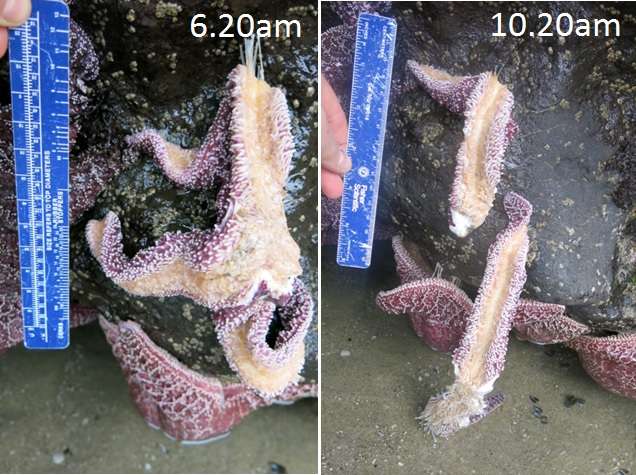Long-term monitoring reveals effects of sea star wasting along Oregon coast

The 2013-2014 sea star wasting epidemic along the Oregon Coast may have been caused by multiple factors and had significant effects on the sea star population and its prey in the area, according to a study published May 4, 2016 in the open-access journal PLOS ONE by Bruce Menge from Oregon State University, USA, and colleagues.
As keystone predators, sea stars affect the biodiversity and abundance of intertidal species. The recent 2013-2014 outbreak of sea star wasting, a viral disease, affected 20 species from Baja California to Alaska, making it among the largest known marine epidemics. The effects of the wasting are severe; afflicted sea stars may lose arms and disintegrate, appearing to "melt." The epidemic reached Oregon in April 2014 and spread along most of the coast by June, infecting about 90 percent of sea stars. Taking advantage of ongoing long-term research and monitoring in the area, the authors of this study tracked the epidemic by performing nearly 150 surveys of the dominant sea star species as well as their mussel prey living in the rocky intertidal habitats at nine sites along the Oregon coast between spring 2014 and fall 2015.
The researchers found that as many as 80 percent of the populations died at the study sites during the epidemic, which occurred during cool water temperatures driven by summer upwelling. Wasting disproportionately affected adults over juveniles, and sea stars in tide pools.
By spring 2015, the authors found that the population was recovering in numbers: study sites had up to 300 times as many new sea stars as in 2014. This recovery may be due to the increased availability of small prey, like mussels, resulting from the previous year's sea star loss. The authors hope that these efforts will aid in calling for a coast-wide investigation of how the wasting epidemic affected intertidal communities along North America's western shores.
Bruce Menge notes: "In contrast to other locations along the US west coast, sea star wasting disease increased during a period of cool, not warm temperatures, suggesting that the cause of wasting outbreaks is multifactorial. Although up to 84% of local populations died, a massive recruitment of sea stars occurred the following spring, suggesting the possibility of rapid recovery."
More information: Menge BA, Cerny-Chipman EB, Johnson A, Sullivan J, Gravem S, Chan F (2016) Sea Star Wasting Disease in the Keystone Predator Pisaster ochraceus in Oregon: Insights into Differential Population Impacts, Recovery, Predation Rate, and Temperature Effects from Long-Term Research. PLoS ONE 11(5): e0153994. DOI: 10.1371/journal.pone.0153994
Journal information: PLoS ONE
Provided by Public Library of Science


















